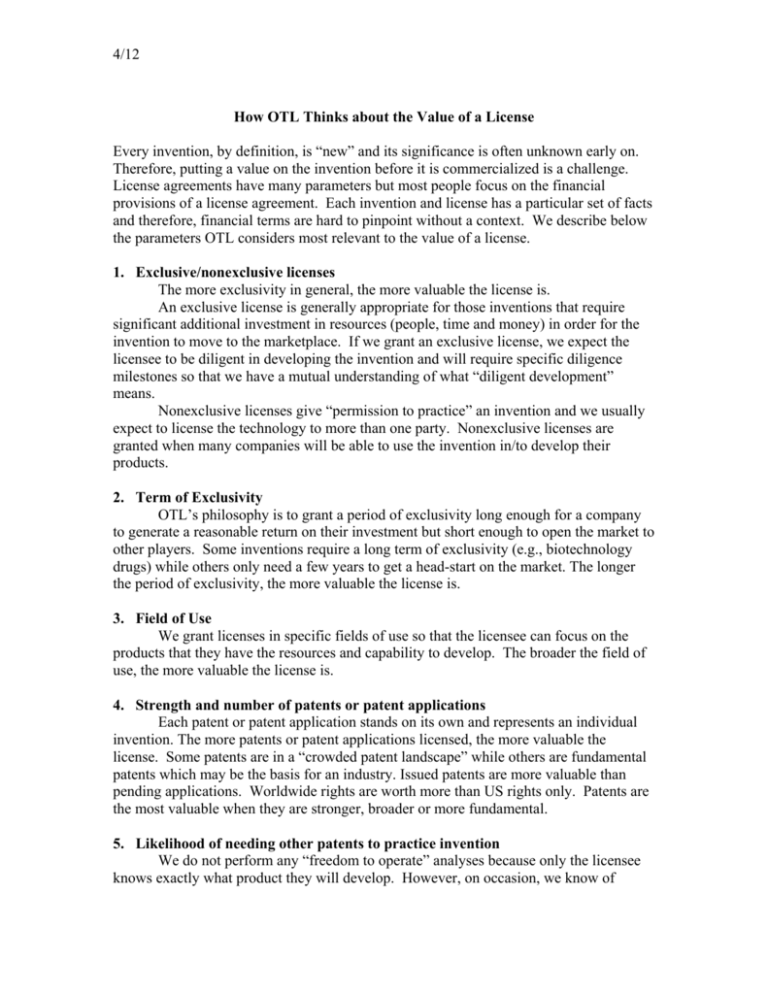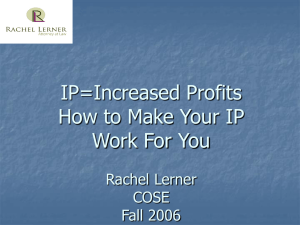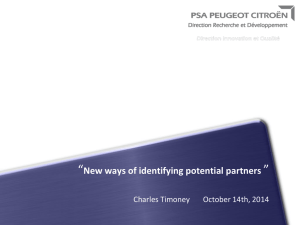4/12 How OTL Thinks about the Value of a License Every invention
advertisement

4/12 How OTL Thinks about the Value of a License Every invention, by definition, is “new” and its significance is often unknown early on. Therefore, putting a value on the invention before it is commercialized is a challenge. License agreements have many parameters but most people focus on the financial provisions of a license agreement. Each invention and license has a particular set of facts and therefore, financial terms are hard to pinpoint without a context. We describe below the parameters OTL considers most relevant to the value of a license. 1. Exclusive/nonexclusive licenses The more exclusivity in general, the more valuable the license is. An exclusive license is generally appropriate for those inventions that require significant additional investment in resources (people, time and money) in order for the invention to move to the marketplace. If we grant an exclusive license, we expect the licensee to be diligent in developing the invention and will require specific diligence milestones so that we have a mutual understanding of what “diligent development” means. Nonexclusive licenses give “permission to practice” an invention and we usually expect to license the technology to more than one party. Nonexclusive licenses are granted when many companies will be able to use the invention in/to develop their products. 2. Term of Exclusivity OTL’s philosophy is to grant a period of exclusivity long enough for a company to generate a reasonable return on their investment but short enough to open the market to other players. Some inventions require a long term of exclusivity (e.g., biotechnology drugs) while others only need a few years to get a head-start on the market. The longer the period of exclusivity, the more valuable the license is. 3. Field of Use We grant licenses in specific fields of use so that the licensee can focus on the products that they have the resources and capability to develop. The broader the field of use, the more valuable the license is. 4. Strength and number of patents or patent applications Each patent or patent application stands on its own and represents an individual invention. The more patents or patent applications licensed, the more valuable the license. Some patents are in a “crowded patent landscape” while others are fundamental patents which may be the basis for an industry. Issued patents are more valuable than pending applications. Worldwide rights are worth more than US rights only. Patents are the most valuable when they are stronger, broader or more fundamental. 5. Likelihood of needing other patents to practice invention We do not perform any “freedom to operate” analyses because only the licensee knows exactly what product they will develop. However, on occasion, we know of 4/12 certain third-party patents that may dominate the invention itself. In those cases, we understand that the licensee may need to take other licenses to successfully commercialize the technology. Therefore, our license may have less value (depending on the third party patents). We can take that into account when negotiating the royalty rate, or provide for a clause that allows for reduction of royalty rate if other licenses are required. 6. The industry This is one of the biggest factors in valuing the license and each industry has its own practices and norms based on its general profit margin and business model. For example, the semiconductor industry typically prefers yearly payments rather than earned royalties because they know that the price of chips always comes down over time. In addition, there may be hundreds of patents in one product (e.g. a computer). The therapeutic drug licensees typically prefer earned royalties. Medical device companies are acutely aware of third party patents and may insist on royalty stacking provisions. We take all these factors into consideration when we propose financial terms. If an invention generates competitive (multiple) interest, or is in a “hot industry,” the financial package will be higher. 7. The Technology’s Central Role Many inventions become the centerpiece component of a product. Some inventions, on the other hand, are only one of many parts and serve as a nice-to-have but not critical role. We are sensitive to the way our technologies are bundled into the final product when we assess the financial value of our technologies. 8. The Commercialization Risks An invention may or may not be fully developed into a successful product. There are many risks involved, and the value of the technology depends on such assessed risks. For example, a very early stage invention may face unknowable market risks – that its market won’t be ready for it for another 20 years, even if the technology is ready. The development risks exist when related technologies may not be ready to support the commercialization of it – for example, manufacturing techniques unable to produce the product in a cost-effective manner. Industry structure may also be a risk factor, where a large monopoly may have little incentive to switch its technology platform, while smaller competitors cannot influence the technology adoption. These are all external factors not directly related to the technology itself, but nevertheless can have a huge impact on the ultimate value of a technology. ***************** Financial Terms OTL looks at the financial terms as a total package i.e., adjustments in one area typically mean adjustments in another. For example, if a company wants to pay less upfront in cash, we may increase the payments in the later years to balance the lower upfront payment, or vice versa. If the company would like to use equity as partial 4/12 consideration of the license, we may balance the perceived value of the equity against future payments. The financial terms are expected to be within the norm of similar licenses for similar technologies. We will always consider the context of the licensee’s business model. Our goal is to have a successful long-term relationship with the licensee where we both share in the success of the technology and company.





